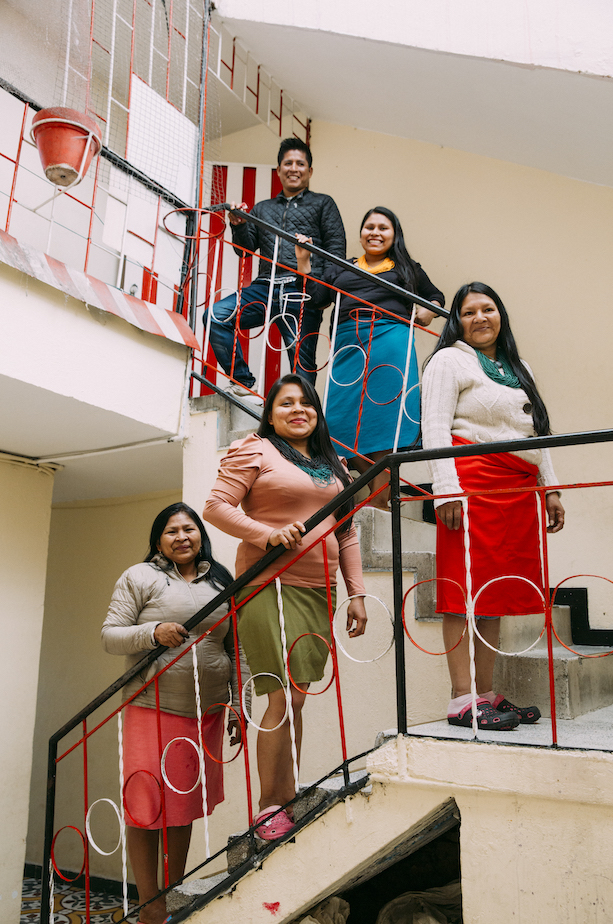
ARTESANOS MITES – TIMBIQUI – CAUCA
El grupo MITES es un grupo de mujeres artesanas conformando por: María del Mar, Gloria, Carmen, María Nilsa, Celina, Liliana, Aide, Felisa, Melida y algunos otros hombres y mujeres, pertenecientes al resguardo indígena GUANGUI en Timbiquí – Cauca en la costa pacífica sur de Colombia.
Hoy en día viven en San Cristóbal, al sur de Bogota, debido al desplazamiento. Cada una de ellas aprendió a tejer en Timbiquí a los 10 años de edad viendo a sus abuelas y mamás hacer el oficio en su día a día, esta es una tradición que se pasa de generación en generación.
Con Alejandro nos conocimos hace 8 años gracias a el proyecto PETLamp y desde ese momento hemos desarrollado objetos de decoración para hogar, tales como canastas, pantallas de lámparas, floreros, entre otras cosas.
El grupo MITES desarrolla canastas, petacas, bolsos, individuales y otros objetos en paja tetera en su día a día, trabajan 3 generaciones y sus hijos están aprendiendo el oficio en Bogotá, adaptando las artesanías al día a día en la ciudad.
The MITES group is a group of women artisans made up of: Maria del Mar, Gloria, Carmen, Maria Nilsa, Celina, Liliana, Aide, Felisa, Melida and some other men and women, belonging to the indigenous resguardo GUANGUI in Timbiquí – Cauca on the south pacific coast of Colombia.
Today they live in San Cristobal, south of Bogota, due to displacement. Each of them learned to weave in Timbiquí at the age of 10 years old watching their grandmothers and mothers doing the craft in their day to day life, this is a tradition that is passed from generation to generation.
With Alejandro we met 8 years ago thanks to the PETLamp project and since then we have developed decorative objects for the home, such as baskets, lampshades, vases, among other things.
The MITES group develops baskets, bags, placemats and other objects in teapot straw on a daily basis, 3 generations work and their children are learning the craft in Bogota, adapting the handicrafts to the daily life in the city.

YANERIS – ARTESANIAS YARANMA – USIACURÍ ATLÁNTICO
Yaneris Angulo es la líder del taller artesanal YARANMA, ubicado en Usiacurí – Atlántico desde hace más de 10 años. Yaranma se dedica a la producción y comercialización de productos elaborados en palma de iraca, como bolsos, individuales, collares, accesorios zapatos entre muchos más artículos; hechos con este material.
Con Alejandro se conocieron gracias al programa DISEÑO COLOMBIA en el año 2018, desde entonces han desarrollado juntos las campanas de las lámparas y mesas iraca.
Yaneris aprendió a tejer gracias a su abuela, quien le enseñó el oficio de la tejeduría para desarrollar cestería. Con el tiempo ella desarrollo la técnica y creció el negocio familiar, hoy en día junto a su equipo desarrolla elementos decorativos para hogar, así como accesorios de moda en paja de iraca.
Yaneris Angulo is the leader of the artisan workshop YARANMA, located in Usiacurí – Atlántico for more than 10 years. Yaranma is dedicated to the production and marketing of products made of iraca palm, such as bags, singles, necklaces, accessories, shoes and many more items made with this material.
With Alejandro they met thanks to the DISEÑO COLOMBIA program in 2018, since then they have developed together the bells of iraca lamps and tables.
Yaneris learned to weave thanks to her grandmother, who taught her the craft of weaving to develop basketry. Over time she developed the technique and grew the family business, today together with her team she develops decorative elements for the home, as well as fashion accessories in iraca straw.

GUILLERMO FORERO – TENJO CUNDINAMARCA
Guillermo es Ingeniero Civil y trabajó durante más de 25 años en el Banco de la República. Después de jubilarse hace más o menos 10 años decidió aprender el oficio de la Carpintería y estudio el programa de madera de la Fundación Santo Domingo por tres años donde tuvo entrenamiento en todas las técnicas de intervención de la madera, en este momento se enamoró del oficio maderero. Con este curso su vida dio un giro y aprendió a amar la talla, el torno, los machihembrados, la pulida, el corte, el ensamble y todo tipo de técnicas relacionadas a la carpintería.
Con Alejandro empezaron a trabajar en el 2017, desarrollando piezas en madera, para las terminación de lámparas y materas.
La madera dio una nueva actividad a Guillermo, después de jubilarse, todos creemos que hasta ahí llegará nuestra labor, pero Guillermo se reinventó y decidió sacar provecho a esa habilidades y curiosidad que tiene por la vida.
Guillermo is a Civil Engineer and worked for more than 25 years at Banco de la República. After retiring about 10 years ago, he decided to learn the carpentry trade and studied the wood program at the Santo Domingo Foundation for three years where he was trained in all woodworking techniques, at this time he fell in love with the woodworking trade. With this course his life took a turn and he learned to love carving, lathe, tongue and groove, polishing, cutting, assembly and all kinds of techniques related to carpentry.
With Alejandro they started working in 2017, developing pieces in wood, for the completion of lamps and materas.
Wood gave a new activity to Guillermo, after retirement, we all believe that our work will end there, but Guillermo reinvented himself and decided to take advantage of the skills and curiosity he has for life.

FRANCISCO SILVA – GUACAMAYAS BOYACÁ
Francisco es un artesano del municipio de Guacamayas en el departamento de Boyacá, desde hace 20 años creo su taller y desarrolla y produce artesanías en fique en la técnica de rollo.
Este oficio lo heredo de su madre, quien aprendió de su abuelo, juntos generación tras generación han pasado el oficio a sus hijos y cada uno ha evolucionado la técnica.
Con Alejandro, se conocieron gracias al programa Diseño Colombia en el año 2019, Francisco desarrolla las bases para las mesas, lámparas y taburetes, de la colección Andes.
Actualmente en el municipio trabajan más de 300 artesanos desarrollando artesanías en fique.
Francisco is an artisan of the municipality of Guacamayas in the department of Boyacá, for 20 years he created his workshop and develops and produces handicrafts in fique in the roll technique.
He inherited this craft from his mother, who learned it from his grandfather, together generation after generation they have passed the craft to their children and each one has evolved the technique.
With Alejandro, they met thanks to the Design Colombia program in 2019, Francisco develops the bases for tables, lamps and stools, from the Andes collection.
Currently, more than 300 artisans work in the municipality developing handicrafts in fique.
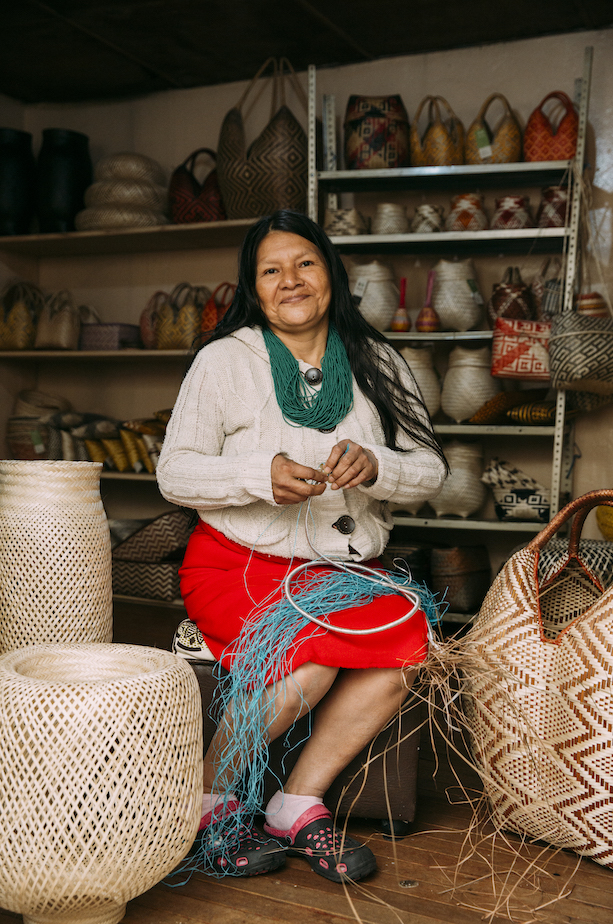
ILDA PIZARIO – WOUNAAN – BAJO SAN JUAN, CHOCO
Ilda, es una mujer perteneciente al pueblo indígena Wounaan que habita en la cuenca del bajo San Juan municipios del litoral de San Juan, Istmina y Pizarro; el río Curiche, municipio de Juradó en Colombia y en la Comarca Emberá-Wounaan en Panamá
Llego a Bogota hace 4 años debido al conflicto armado de Colombia. Ella teje en Werregue, es una fibra natural la cual proviene del Choco, municipio colombia y en donde se encuentra la Selva más húmeda del mundo. La palma de Werregue, es un palma espinosa, similar a la palma del Chontaduro, para extraer la fibra se debe sacar el cogollo, luego pelarlo y secarlo al sol, una vez este completamente seco se tintura de manera natural con semillas, raíces y minerales de la zona (hoy en día se tienen algunos colores con tintes artificiales) Luego se saca cada hilo, los cuales tienen menos de 1 milímetro de grosor.
Aprendió a tejer en el bajo San Juan viendo a su abuela tejer, desde muy pequeña aprendió esta técnica y hoy en dia desarrolla productos artesanales en la ciudad de Bogotá.
Con Alejandro se conocieron en el 2021, y desarrolla objetos en Werregue los cuales son mezclados con Paja Tetera para la creación de platones y mesas d ella colección de Alta Estudio.
Ilda is a woman belonging to the Wounaan indigenous people who lives in the basin of the Bajo San Juan, municipalities of the San Juan, Istmina and Pizarro coast; the Curiche River, municipality of Juradó in Colombia and in the Emberá-Wounaan Comarca in Panama.
She arrived in Bogota 4 years ago due to the armed conflict in Colombia. She weaves in Werregue, a natural fiber which comes from the Choco, a Colombian municipality where the wettest rainforest in the world is located. The Werregue palm, is a thorny palm, similar to the Chontaduro palm, to extract the fiber the heart must be removed, then peeled and dried in the sun, once it is completely dry it is dyed naturally with seeds, roots and minerals from the area (today there are some colors with artificial dyes) Then each thread is removed, which are less than 1 millimeter thick.
She learned to weave in the Bajo San Juan watching her grandmother weave, from a very young age she learned this technique and today she develops handmade products in the city of Bogota.
With Alejandro they met in 2021, and she develops objects in Werregue which are mixed with Paja Tetera for the creation of platters and tables of the Alta Estudio collection.
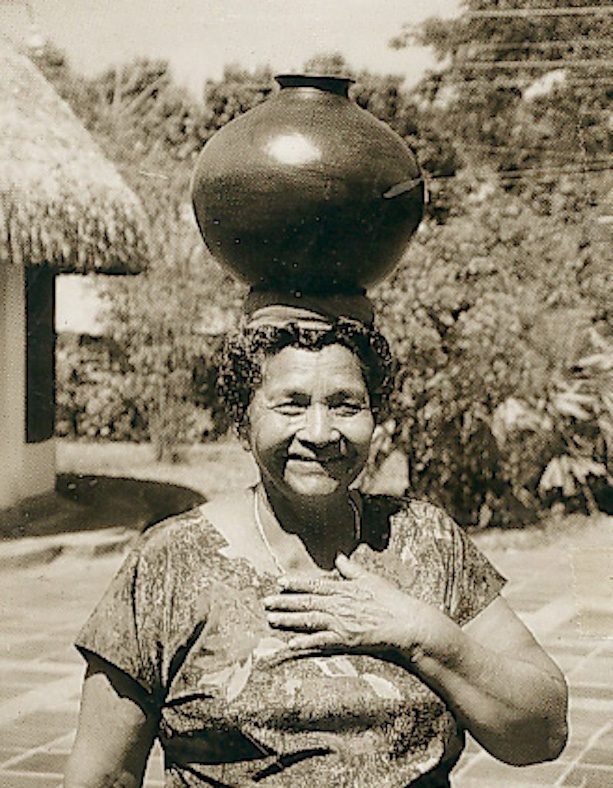
ARTESANIAS DE LA CHAMBA – LA CHAMBA, TOLIMA
La vereda de La Chamba es uno de los centros cerámicos más reconocidos del país. Está ubicada en el departamento del Tolima a 10 km del casco urbano y a 14 km de El Espinal. Su economía está basada en la producción agropecuaria y la elaboración de artesanías es llevada a cabo por más del 85% de su población.
Desde hace más de trescientos años los pobladores de este corregimiento se han dedicado a la alfarería y sus conocimientos han pasado de generación en generación, hasta convertir en tradición el trabajo del barro y la creación de piezas que llevan consigo la historia y la cultura de una región típicamente artesanal.
Los primeros pueblos que habitaron el valle del río Magdalena fueron los Poinco o Yaporogo de la cultura Pijao. Ellos elaboraban piezas en cerámica como múcuras y recipientes, con fines utilitarios y ceremoniales. Por esta razón, a comienzos del siglo XX la cerámica de La Chamba tenía las características de esta cultura indígena.
The village of La Chamba is one of the most recognized ceramic centers in the country. It is located in the department of Tolima, 10 km from the town center and 14 km from El Espinal. Its economy is based on agricultural production and the production of handicrafts is carried out by more than 85% of its population.
For more than three hundred years the inhabitants of this township have been dedicated to pottery and their knowledge has been passed from generation to generation, to become a tradition of working clay and creating pieces that carry with them the history and culture of a typically artisanal region.
The first people to inhabit the Magdalena River valley were the Poinco or Yaporogo of the Pijao culture. They made ceramic pieces such as múcuras and vessels for utilitarian and ceremonial purposes. For this reason, at the beginning of the 20th century the ceramics of La Chamba had the characteristics of this indigenous culture. Currently the pieces of this region are worked in the traditional way in red clay taken from the same territory and with different engobes and burnings they are given that black color of La Chamba, which is one of the Colombian handicrafts with denomination of origin.

JAIME, ROSALVA Y LIS – COMUNIDAD INGA Y KAMENTSA – PUTUMAYO
Lis, su mamá Rosalva y Jaime son los encargados de darle viva a los objetos de la colección Insecta y Pieles. Forman parte de un grupo indígena de mezclas y tradiciones poderosas. Por un lado, forman parte de la comunidad Inga descendientes de los incas del Perú y por el otro, pertenecen a la comunidad Kamentza, que se caracteriza por ser un pueblo indígena único en el mundo, ya que a día de hoy su procedencia es un misterio.
De niños aprendieron a trabajar la tierra, a cuidar las plantas pero sobre todo a respetar La Madre Tierra. Hace 14 años empezaron a trabajar las artesanias, junto con sus hermanos formaron un taller y empezaron a hacer pulseras y collares con semillas y chaquiras. Hace 5 años formaron el Taller Shinyak, que en lengua materna significa «fuego» en donde desarrollan diferentes artesanias en talla de maderas locales y enchape de mostacillas. Las maderas con las que trabajan en Shinyak son maderas de árboles caídos, los cuales se dejan secar y es un tradición que su padre le transmitió y hoy en día están enseñando este conocimiento a las nuevas generaciones. El respeto a la naturaleza y los materiales que ella provee son características muy importantes en los procesos de trabajo de esta comunidad.
Desde 2020, Lis y el taller Shinyak, entrar a formar parte del grupo de artesanos colombianos con los que se trabaja mano a mano, desarrollando objetos de calidad con diseño atemporal y técnicas tradicionales.
Lis, her mother Rosalva and Jaime are in charge of giving life to the objects in the Insecta and Pieles collection. They are part of an indigenous group of powerful mixtures and traditions. On the one hand, they are part of the Inga community, descendants of the Incas of Peru, and on the other hand, they belong to the Kamentza community, which is characterized by being a unique indigenous people in the world, since to this day their origin is a mystery.
As children they learned to work the land, to take care of the plants, but above all to respect Mother Earth. Fourteen years ago they started to work with handicrafts, together with their brothers they formed a workshop and began to make bracelets and necklaces with seeds and beads. Five years ago they formed the Shinyak Workshop, which in their mother tongue means «fire», where they develop different handicrafts in local wood carving and beads veneer. The wood with which they work in Shinyak is wood from fallen trees, which are left to dry and is a tradition that his father passed on to him and today they are teaching this knowledge to the new generations. Respect for nature and the materials it provides are very important characteristics in the work processes of this community.
Since 2020, Lis and the Shinyak workshop, become part of the group of Colombian artisans with whom they work hand in hand, developing quality objects with timeless design and traditional techniques.
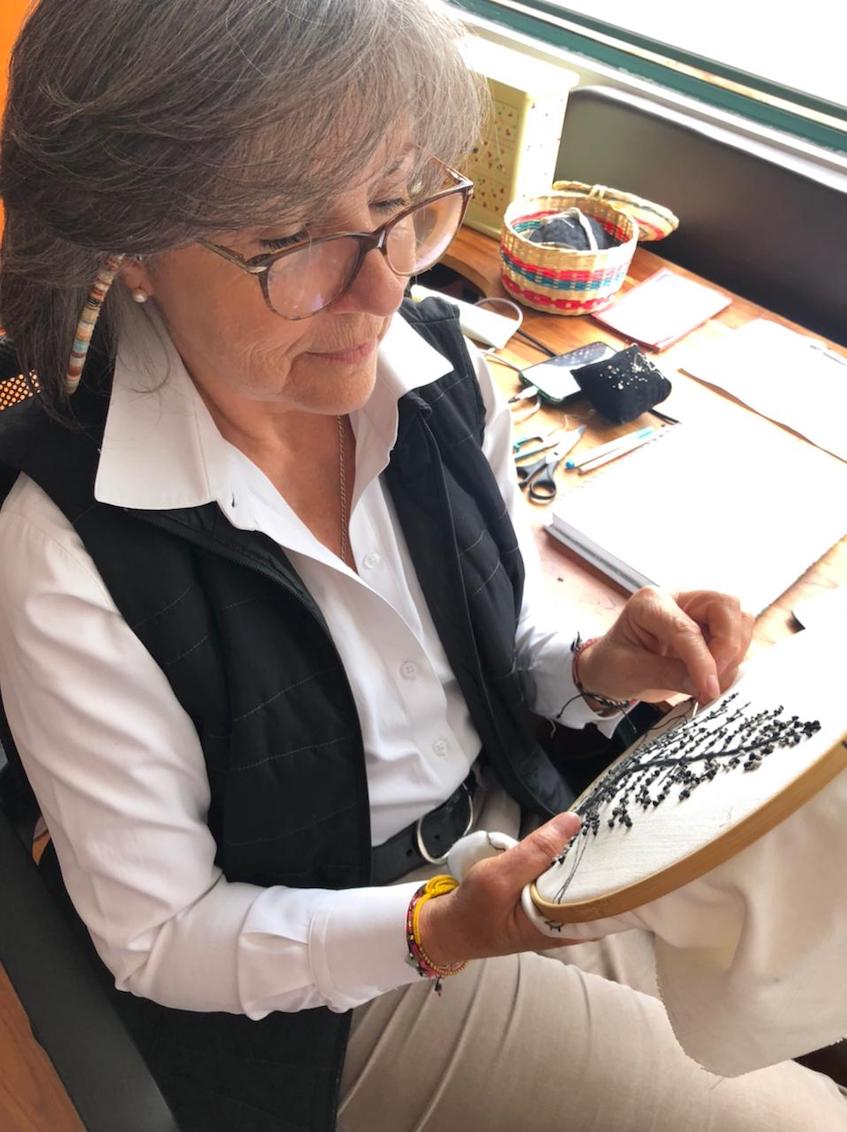
ELSA MARIA HERNANDEZ – BOGOTÁ
Elsa María, es MI MAMA, terapista ocupacional de profesión pero siempre ha tenido muchísima habilidad para el arte y las manualidades; es madre, hija, abuela, artista, cocinera, terapista con técnicas alternativas, medio bruja y con un saber innato.
Desde muy pequeña aprendió a bordar, viendo a su mamá y su abuela, con el bordado, Elsa puede representar infinidad de objetos, paisajes, animales… jugando con diferentes técnicas y materias primas.
Trabaja para Alta Estudio desde el 2020, desarrollando los bordados en cojines, lámparas, puffs, esteras y nuevos elementos. Trabajando con lanas e hilos de algodón. Cada pieza es una creación hecha 100% a mano por esta mujer que busca que sus creaciones permanezcan en el tiempo a trevez de su arte.
Elsa Maria, is MY MOTHER, occupational therapist by profession but she has always had a great ability for art and crafts; she is a mother, daughter, grandmother, artist, cook, therapist with alternative techniques, half witch and with an innate knowledge.
From a very young age she learned to embroider, watching her mother and grandmother, with embroidery, Elsa can represent countless objects, landscapes, animals… playing with different techniques and raw materials.
She has been working for Alta Estudio since 2020, developing embroidery on cushions, lamps, puffs, mats and new elements. Working with wool and cotton threads. Each piece is a 100% handmade creation by this woman who seeks that her creations remain in time through her art.
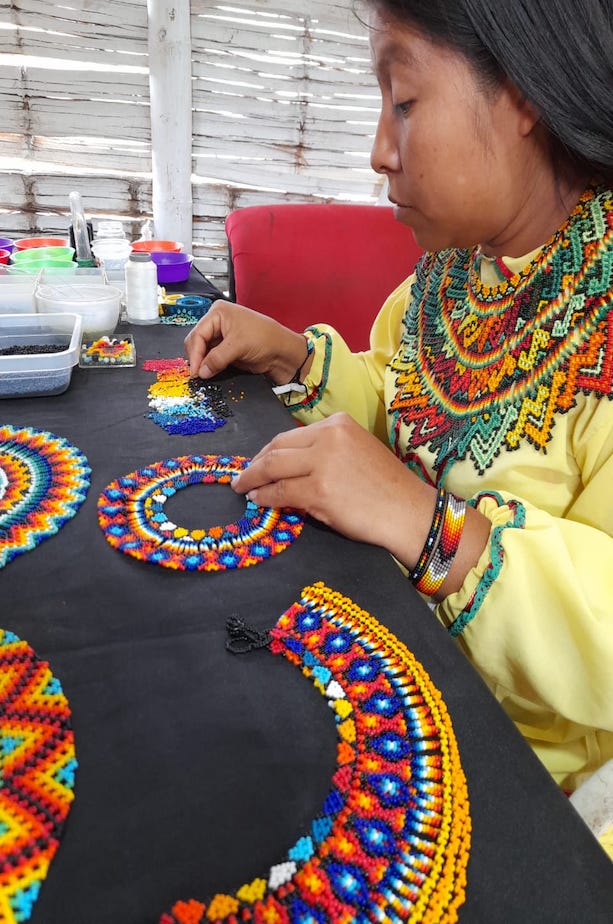
JAIWERA ARTESANOS – EMBERÁ CHAMI – RISARALDA
La comunidad Emberá Chami proviene de un resguardo indígena, ubicado en la montaña, oculto al mundo en la vereda Pueblo Rico en Risaralda, en donde se conserva su cultura, vestimenta, comida, danzas, música, medicina y dialecto.
Jaiwera significa «mujer líder con capacidad de poder liderar una comunidad, una mujer feliz, sin sentimientos de tristeza, mujer capaz de sanar y guiar a la mejor forma.
Las piezas de los Emberá Cami son reconocidas mundialmente, por su ejecución y calidad. Cada trabajo se considera una obra de arte desarrollado en chaquiras checas, tejidas cuenca a cuenta para desarrollar los dibujos y tejidos que los caracteriza. Cada pieza tiene varias mezclas de colores las cuales son inspiradas en los pájaros, plantas, arboles, ríos y piedras del territorio.
El Taller Jaiwera fue fundado en 2009, hoy en dia trabajan 12 familias desarrollando la artesanía tradicional que tanto los caracteriza.
Con Alta Estudio empezaron a colaborar en el año 2021, desarrollando objetos como collares y ornamentos diseñados por Alejandro para complementar los diseños de la marca.
The Emberá Chami community comes from an indigenous reservation, located in the mountains, hidden from the world in the village of Pueblo Rico in Risaralda, where their culture, clothing, food, dances, music, medicine and dialect are preserved.
Jaiwera means «woman leader with the capacity to lead a community, a happy woman, without feelings of sadness, a woman capable of healing and guiding in the best way.
The Emberá Cami pieces are recognized worldwide for their execution and quality. Each work is considered a work of art developed in Czech beads, woven by hand to develop the drawings and weavings that characterize them. Each piece has several mixtures of colors which are inspired by the birds, plants, trees, rivers and stones of the territory.
Taller Jaiwera was founded in 2009, today 12 families work developing the traditional craftsmanship that characterizes them so much.
They began collaborating with Alta Estudio in 2021, developing objects such as necklaces and ornaments designed by Alejandro to complement the brand’s designs.
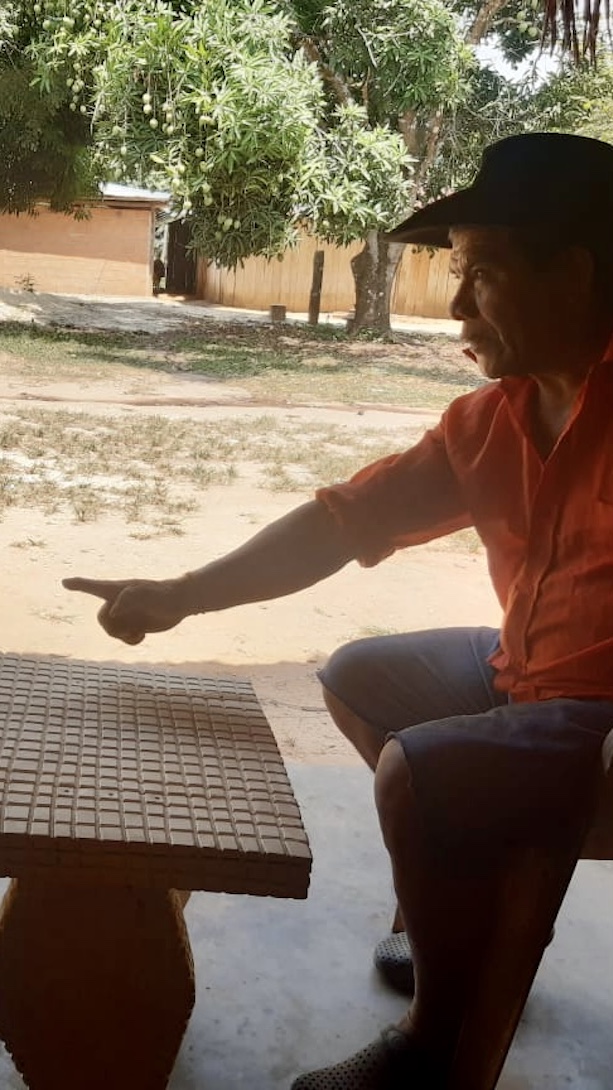
JAIRO YEPEZ – RESGUARDO WACOYO, SIKUANI – META.
El pueblo Sikuani pertenece a la familia lingüística “Guahibo”, que integra a las comunidades indígenas Guayabero, Kuiba, Hitnü y Sikuani, ubicados en los departamentos del Meta, Vichada, Casanare, Arauca y parte de los llanos venezolanos. Este grupo, al igual que varios de los ubicados en los llanos del Orinoco en producto de una serie de sucesivas migraciones procedentes de diversas partes del continente americano. Cuentan los Sikuani, que su pueblo surgió de un pozo localizado en una zona llamada “Unianto-iboto”, cerca del río Orinoco, en un lugar del departamento del Vichada. Allí nacieron los diferentes clanes llamados “momowi” que son descendientes o nietos del carpintero, del mono, del tigre, del caimán y de los comedores de carne (los kawiri), entre otros. Cada uno de estos grupos nació con su propia forma de hablar y de ser, de acuerdo con la característica del animal de su ascendencia. De esa manera conforman hoy los grupos locales o familias extensas de las comunidades Sikuani.
Según la tradición oral los Sikuani migraron a estos lugares siguiendo la ruta denominada diosonamüto, expresión que traduce literalmente ‘El camino de dios’. Esta ruta representa el recorrido que hizo el dios Nakuanü, cuando estaba conformando el mundo; es una vía que no atraviesa ningún curso de agua y va desde el Orinoco hasta la Cordillera Oriental por los departamentos del Vichada y del Meta.
Probablemente, por este camino se llevó a cabo el poblamiento ancestral, ya que los Sikuani migraron desde el oriente hasta la parte baja de la cordillera en el occidente, por lo cual su direccionalidad está marcada lingüísticamente por esas dos direcciones, betsia (hacía arriba) y bereka (hacia abajo).
The Sikuani people belong to the «Guahibo» linguistic family, which integrates the Guayabero, Kuiba, Hitnü and Sikuani indigenous communities, located in the departments of Meta, Vichada, Casanare, Arauca and part of the Venezuelan plains. This group, as well as several of those located in the Orinoco plains, is the product of a series of successive migrations from different parts of the American continent. The Sikuani tell that their people emerged from a well located in an area called «Unianto-iboto», near the Orinoco River, in a place in the department of Vichada. There, the different clans called «momowi» were born, which are descendants or grandchildren of the carpenter, the monkey, the tiger, the caiman and the meat eaters (the kawiri), among others. Each of these groups was born with its own way of speaking and being, according to the characteristic of the animal of their ancestry. In this way they form today the local groups or extended families of the Sikuani communities.
According to the oral tradition, the Sikuani migrated to these places following the route called diosonamüto, an expression that literally translates as ‘God’s path’. This route represents the journey made by the god Nakuanü, when he was shaping the world; it is a road that does not cross any watercourse and goes from the Orinoco to the Eastern Cordillera through the departments of Vichada and Meta.
Probably, the ancestral settlement took place along this road, since the Sikuani migrated from the east to the lower part of the mountain range in the west, which is why their directionality is linguistically marked by these two directions, betsia (upwards) and bereka (downwards).
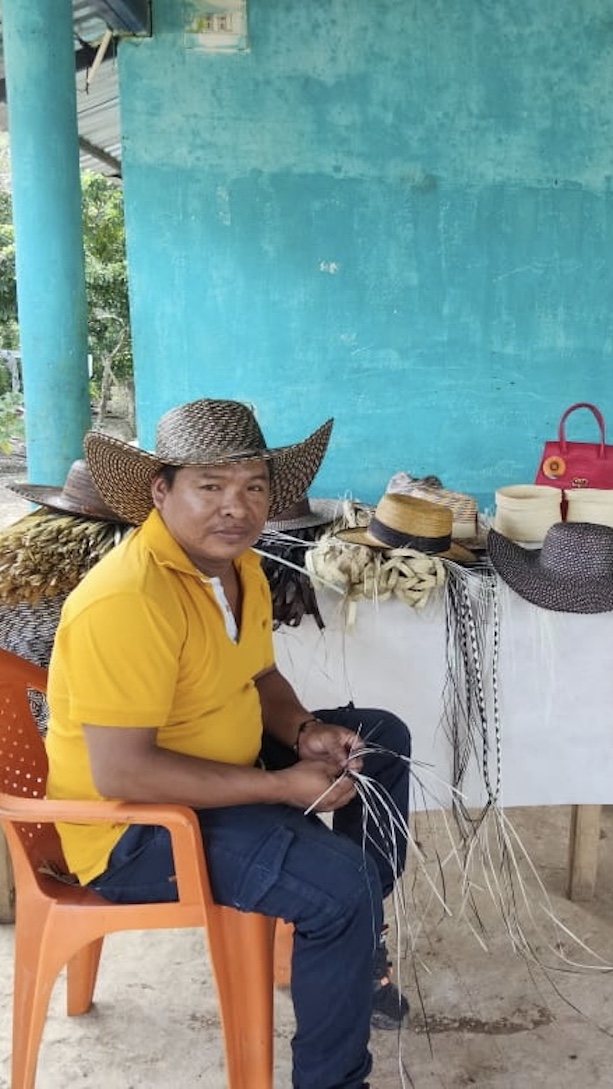
ANTONIO MARQUEZ – ARTESANIAS DE SAN ANTONIO DE PALMITO, SUCRE
El oficio que se desarrolla en el municipio de San Antonio de Palmito es la tejeduría en caña flecha, este es uno de los oficios más reconocidos a nivel nacional pues es el origen del emblemático “sombrero vueltiao” que tanto representa los colombianos.
La tejeduría en caña flecha es de origen indigna más específicamente del resguardo Zenú establecido entre Córdoba y Sucre. Este oficio consiste en el trenzado de fibras de caña flecha (gynerium sagitariom) que es una planta silvestre de clima tropical que se da a las orillas de quebradas o pantanos y que con el tiempo la lograron cultivar.
The trade that is developed in the municipality of San Antonio de Palmito is the weaving in caña flecha, this is one of the most recognized trades at national level because it is the origin of the emblematic «vueltiao hat» that represents so much the Colombians.
The weaving in caña flecha is of indigenous origin, more specifically from the Zenú reservation established between Córdoba and Sucre. This craft consists of braiding the fibers of caña flecha (gynerium sagitariom) which is a wild plant of tropical climate that grows on the banks of streams or marshes and that over time they managed to cultivate it.
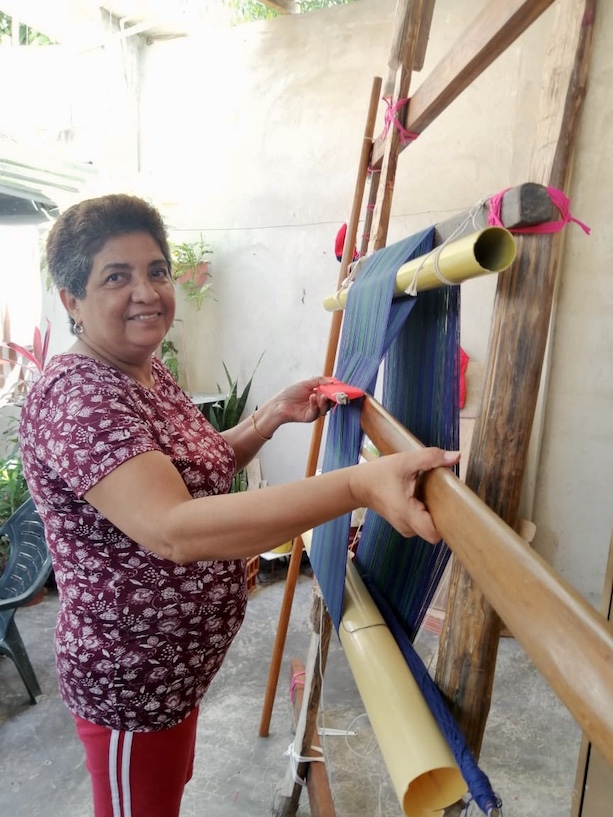
CELMIRA BUELVAS – SAN JACINTO – BOLIVAR.
Tierra de los antiguos Zenú, San Jacinto es un pueblo ubicado en el departamento de Bolivar.
Los Zenú, artesanos famosos por su oficio de producción textil en telar, dormían en hamacas producidos en amplios telares verticales que se instalaban dentro de sus casas para tejer con hilazas de algodón. Esta técnica cuenta con el sello de Denominación de origen y es una de las artesanías más apetecidas de nuestro país.
Land of the ancient Zenú, San Jacinto is a town located in the department of Bolivar.
The Zenú, artisans famous for their craft of textile loom production, slept in hammocks produced on large vertical looms that were installed inside their houses to weave with cotton yarn. This technique has the seal of Denomination of Origin and is one of the most popular handicrafts in our country.

